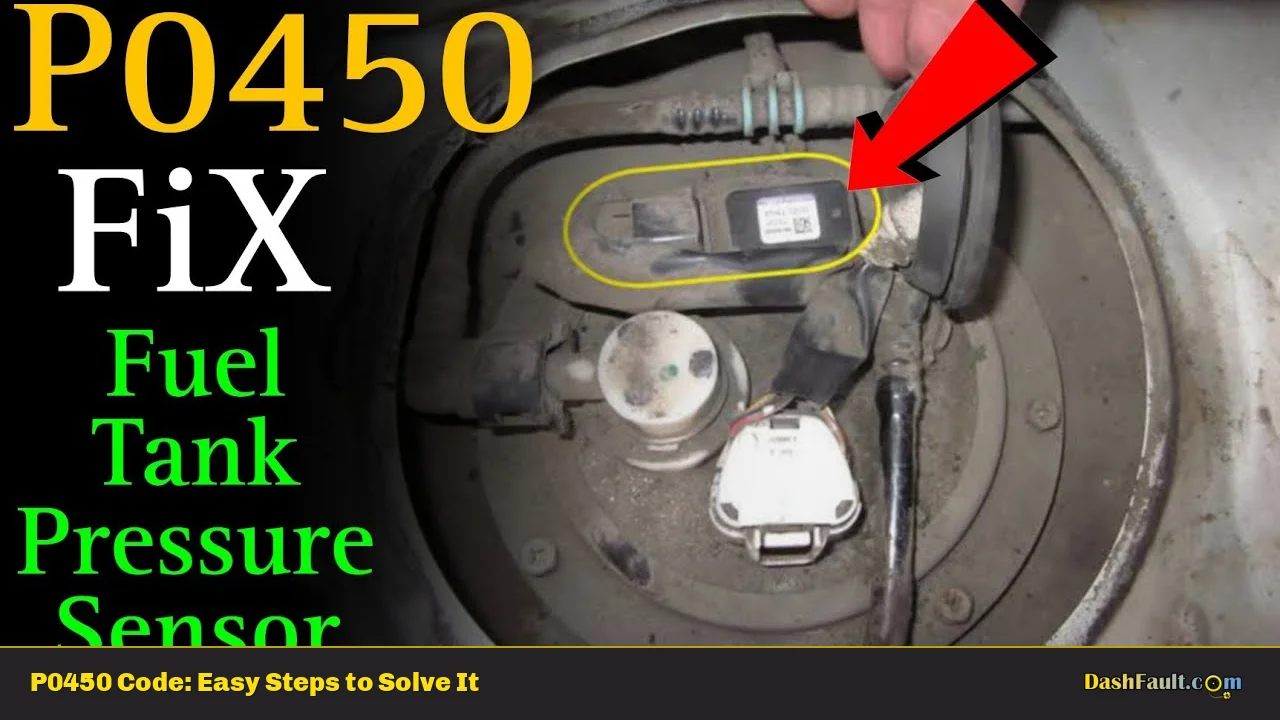The P0450 trouble code signifies a malfunction in the Evaporative Emission Control (EVAP) System pressure sensor or circuit. This system is crucial for capturing fuel vapors from the fuel tank, preventing them from escaping into the atmosphere, and ensuring that these vapors are properly utilized in the combustion process. When the Powertrain Control Module (PCM) detects an issue with the pressure sensor’s readings, it triggers the P0450 code, indicating that further investigation is necessary to identify and rectify the underlying problem.
| P0450 Code Meaning | P0450 Code Common Causes |
|---|---|
| Evaporative Emission Control System Pressure Sensor Malfunction | Loose or damaged gas cap |
| Pressure sensor circuit malfunction | Leaking EVAP hoses or components |
| Faulty EVAP pressure sensor | Defective purge or vent valve |
| Wiring issues in the EVAP system | Damaged charcoal canister |
| Faulty PCM (rare) |
Symptoms of P0450 Code
When a vehicle registers a P0450 code, drivers may experience various symptoms, although some vehicles may show no noticeable signs. Common symptoms include:
- Illuminated Check Engine Light
- Noticeable fuel odor due to vapor leaks
- Occasional difficulty starting the engine
- Rough engine operation in some cases
Technical Explanations
The EVAP system’s primary function is to capture and store fuel vapors from the fuel tank, preventing them from escaping into the environment. It utilizes a series of components, including a pressure sensor, purge valve, vent valve, and charcoal canister. The pressure sensor monitors changes in pressure within the system and relays this information to the PCM. If the PCM detects that the pressure readings are outside of specified parameters—typically below 0.5 volts or above 4.8 volts for an extended period—it sets the P0450 code.
Step-by-Step Diagnosis
Diagnosing a P0450 code involves several steps:
- Visual Inspection: Begin by inspecting the gas cap for damage or improper sealing. Ensure it clicks securely when closed.
- Check EVAP Hoses: Examine all hoses connected to the EVAP system for cracks, leaks, or disconnections.
- Scan for Codes: Use an OBD-II scanner to retrieve any additional trouble codes that may provide further insight into related issues.
- Smoke Test: Conduct a smoke test to identify any leaks within the EVAP system.
- Test Pressure Sensor: Measure voltage at the EVAP pressure sensor connector while monitoring changes in pressure.
- Inspect Wiring: Check for damaged wires or poor connections leading to and from the pressure sensor.
Solution Methods
Resolving a P0450 code typically involves one or more of the following solutions:
- Replace Gas Cap: If found loose or damaged, replacing it is often a simple fix.
- Repair Leaks: Fix any identified leaks in hoses or connections within the EVAP system.
- Replace Faulty Components: If testing reveals a defective pressure sensor, purge valve, or vent valve, replace these components as necessary.
- Wiring Repairs: Address any wiring issues such as shorts, opens, or corrosion that could affect signal transmission.
Cost Estimates
The cost to diagnose and repair a P0450 code can vary widely based on location and vehicle type. Typical expenses include:
- Diagnostic Fee: $75 – $150 for professional diagnostics.
- Gas Cap Replacement: $10 – $30 for a new gas cap.
- EVAP System Repairs: $100 – $500 depending on parts and labor required for repairs like hose replacements or sensor installations.
- Professional Help: If multiple parts need replacement or if wiring issues are complex, costs could rise significantly.
Warnings and Recommendations
While a P0450 code does not pose an immediate safety risk, ignoring it can lead to increased emissions and reduced fuel efficiency. Additionally, unresolved issues may cause further damage to other components over time.
It is advisable to address this trouble code promptly:
- Always consult your vehicle’s service manual for specific diagnostic procedures related to your make and model.
- If you are not comfortable performing these diagnostics yourself, seek assistance from a qualified mechanic.
Closing Paragraph
In summary, understanding and addressing a P0450 trouble code is essential for maintaining your vehicle’s performance and compliance with emissions regulations. By following proper diagnostic steps and implementing effective solutions, vehicle owners can resolve this issue efficiently. Regular maintenance of your EVAP system components can prevent future occurrences of this trouble code.
Frequently Asked Questions About P0450
- What does the P0450 code mean?
The P0450 code indicates a malfunction in the Evaporative Emission Control System pressure sensor. - Is it safe to drive with a P0450 code?
While it is not immediately dangerous, it can lead to increased emissions and reduced fuel efficiency if left unresolved. - What are common causes of a P0450 code?
Common causes include a loose gas cap, faulty EVAP pressure sensor, damaged hoses, or wiring issues. - How do I diagnose a P0450 code?
Start with visual inspections of components, use an OBD-II scanner for additional codes, perform smoke tests for leaks, and check voltage at sensors. - Can I fix a P0450 code myself?
Yes, many DIY mechanics can address simple fixes like replacing gas caps or hoses; however, complex issues may require professional help. - What tools do I need to diagnose this code?
A basic OBD-II scanner and some hand tools will suffice for most diagnostics related to this issue. - Will clearing the code fix my problem?
No; clearing the code will not resolve underlying issues; it will only reset the check engine light temporarily. - How long does it take to repair a P0450 issue?
The time required varies based on the specific cause but typically ranges from 30 minutes to several hours depending on repairs needed.
